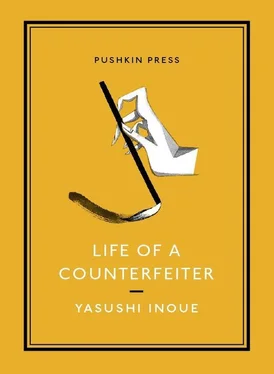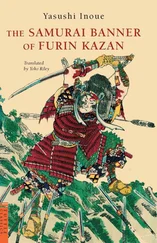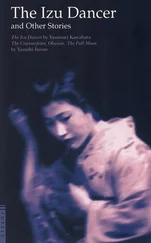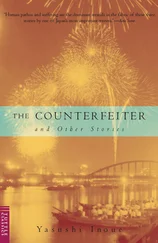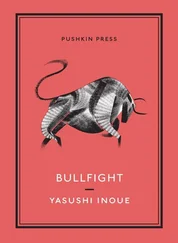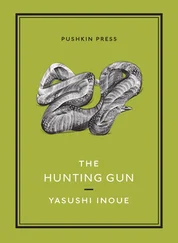My primary purpose in coming on this trip was to view the paintings, but Takuhiko seemed to see it as an occasion to thank these families for throwing their weight behind his father during his life. At each house, we would hear an anecdote or two about the young Keigaku; sometimes, if the title of one of the scrolls in a collection hadn’t been marked on its box, Takuhiko would be asked to take up a brush and write it in his own calligraphy, along with his father’s name. “All right,” he would say, an expression settling onto his face — under those bushy eyebrows, his close-cropped hair — that displayed a competitiveness he had inherited from his father, “let’s have a go.” And with that he would roll up his sleeves, baring arms that seemed too sturdy for a man who claimed to have set Paris on fire with rumors of his exploits, and write the characters in a style startlingly similar to Keigaku’s.
I had hit it off unusually well with Takuhiko, who was my age and now well established as the second artist in Keigaku’s family, and we had quickly grown friendly enough to speak quite candidly with each other. Takuhiko had lived such a thoroughly debauched life abroad that when he came back to Japan it felt ridiculous to go on that way, and just like that he reinvented himself, ceasing to bother about appearances or reputation, acquiring the air of a man from some far-off country casting cynical sideways glances at the chaotic goings-on of wartime Japan. He combined a haughty, audacious streak predictable in the son of a genius with the cheerful affability of a man from a good family. The reports I had heard before we met were so off the mark I hardly knew what to think; being the successor to a celebrated painter had, it seemed, subjected him to misunderstandings on every front.
Although Takuhiko had inherited a remarkable artistic talent from his father, he had a reputation as a lazy good-for-nothing, and, even though there was nothing at all stylish about him, no tendency to posture, rumor had it that he was a foppish playboy. Of course, he had inherited enormous wealth upon his father’s death, along with a magnificent estate and a vacation house, so while I suppose you could have described him as a sculptor by trade, in actuality he didn’t do anything, and didn’t need to. Essentially the only tasks on his plate were to put out his father’s biography before Japan finally lost the war, and then maybe publish a luxurious catalog of Keigaku’s works.
In the course of our five-day trip together, Takuhiko and I encountered something quite intriguing that neither of us had expected. Every house we visited had, it turned out, a painting — and usually only one — that purported to be Keigaku’s, but was in fact a forgery. We came across these works with such regularity it almost seemed the families must have gotten together and planned it.
The first was at the house of the wealthy M. family in Kakogawa, whose head had already died.
They showed us several of Keigaku’s paintings in an inner room that looked out onto a carefully tended enclosed garden. Among them was one small scroll whose box bore the title “Autumn Scene, North of the Capital,” evidently meant for use in the tea ceremony. I spotted it as a forgery as soon as it was unrolled, and Takuhiko, who had been peering down at it from the side, immediately glanced up at me, so that our gazes unexpectedly collided, and clung together for a moment.
“What do you think?” his eyes were saying.
I had seen exactly the same painting at the house of a collector in Kyoto, but Takuhiko could tell right away, even without referencing such external circumstances, as he later explained, simply because there was a certain lack of grace in the execution. At any rate, the work had obviously been copied from a photograph in a catalog or some such thing. Just in case, we checked the manual of Keigaku’s seals, and sure enough the one on this scroll was unmistakably a copy, evidently carved from wood, of the original stone “Tekishintei” seal. At first glance it appeared to be quite skillfully done, but when we lined the two marks up side by side the discrepancies were clear. The vermilion ink was a different shade, as well, and while the box had a title on it, as it should, the calligraphy was fake.
When we asked about the painting, the widow of the house told us her late husband had bought it from a painter named Hara Hōsen, a friend of Keigaku’s who had temporarily taken up residence in Kakogawa and had gone around with a number of old pieces; she herself had been acquainted with the man, though she had no idea what had become of him.
“Ah, Hara Hōsen!” Takuhiko said when he heard this. “I know him, too, actually. I’m not entirely sure when it might have been, but I remember meeting him two or three times as a boy. It’s true he was a friend of my father’s, and he used to come over fairly often, but from what I’ve heard he made forgeries of my dad’s paintings at some point, and after that my dad refused to see him. Seems the story was true.”
This experience with the M. family in Kakogawa turned out to be only the beginning; at one house after the next, day after day, we were shown Keigakus painted by Hara Hōsen.
“Another Hōsen, huh?”
“This one’s quite good, actually — almost better than the real thing.”
Each time, after exchanging a few remarks of this sort, we would inform the unfortunate owners that the piece was a counterfeit. In some cases we could tell at a glance that the painting was fake, but some of the imitations were surprisingly skillful. Still, they could be clearly distinguished from originals by their lack of a certain innate quality, or by their less commanding aura — they were fakes, after all — and upon careful examination there was always some blatant mistake.
From his middle period on, Keigaku abandoned the use of short, pale-green lines in depicting the surfaces of boulders, grass or moss, and so sometimes one could instantly point to an error of this sort; in other cases, Keigaku’s unusual technique of applying azure blue near the bottom of the snow in paintings of Mt. Fuji in the summer — a favorite theme of his — had been so sloppily mimicked that it could be cited as evidence of a fake. In every instance, without exception, the counterfeits revealed themselves.
That Hōsen was responsible for all these forgeries was evident from the routes by which they had been acquired. He must have been an exceptionally adroit man, because in the large majority of cases he seemed not only to have painted the work, but also to have prepared the different seals and even done the calligraphy on the box; indeed, of the dozen or so forgeries we saw during our trip, only two appeared to have been sold in partnership with sketchy country art dealers.
There was a reason for this: in his interactions with buyers, Hōsen had usually invoked his friendship with Keigaku as his trump card, using this to gain their trust before telling them he had received a certain painting as a gift from Keigaku, or bought it for very little, and then pushing the forgery onto them. On other occasions, Hōsen would offer to ask Keigaku to do a painting for the buyer, and then, after waiting for a plausible amount time, he would bring the painting along.
As I noted, only two works had come to their buyers through an unscrupulous, unidentified dealer. Still, this indicated that at some point Hōsen had indeed partnered with such a person to sell his forgeries, and that made the whole business even more serious.
During our trip, Takuhiko and I took to calling the counterfeiter by different names: “Hara Keigaku,” “old man Hara,” and so on. We had the opportunity to inspect a dozen or so of his counterfeits, and gleaned scraps of knowledge about the man from talking with their owners, but the stories we heard all dated from when he was in his forties and fifties, from the period when he had lived in the area, roving from place to place as an unknown local painter; the most we could do to satisfy our curiosity about the extent of his friendship with the young Keigaku was to speculate on the basis of Takuhiko’s hazy memories.
Читать дальше
